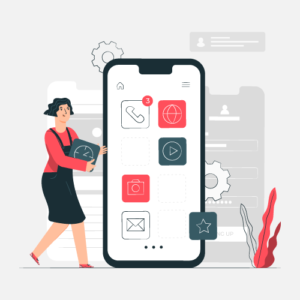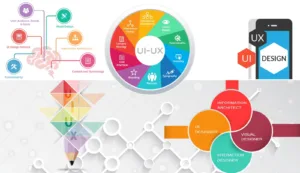If you’re a mobile app developer, then you’ve probably come across the term “UI developer.” You might have also wondered what it is exactly that they do as part of your project team. Well, here’s a quick overview of all you need to know about being a UI developer:
1. The UI developer works with the UX designer and graphic designer
The UI developer works with the UX designer and graphic designer to create a user interface. The UX designer creates the user experience, which is how users interact with your app, while the graphic designer creates the visual design of your app.
The UI developer is responsible for implementing those designs into code that can be used by other developers who may want to build on top of yours or create something similar in their own apps.
2. The UI developer can create mobile app graphics and animations
A UI developer is responsible for all graphical elements in the app. This means that they are responsible for all of the visual design, including:
- Graphics, such as buttons and images
- Animations (or motion) of these graphics
So what does this mean? When you’re looking at a mobile app that has been created by another developer or agency, chances are good that it will have been designed with some sort of animation or graphic element.
In fact, even if you’re using an existing template for your own project, there will probably be some parts that just don’t look right because they were created by someone else—and thus won’t match up well with how you want things to look when users see them on their devices.
3. The UI developer creates wireframes and mockups
Wireframes are a visual representation of the app’s user interface and are created to help communicate ideas to the client. They can include text, images, icons, and other design elements. Wireframes are created in programs like Axure, Omnigraffle, and Visio (which also have wireframing capabilities).
After creating wireframes with Axure or OmniGraffle/Visio you’ll need to export them as PDFs so that your client can view them on their computer without having access to any of your project files.

4. The UI developer’s role involves UI usability testing – working with end users
The role of the UI developer involves UI usability testing – working with end users.
The UI developer should be able to work with both mobile and web applications, so it’s important that they have experience working on both platforms. They should also be familiar with common user tasks, such as searching for content on a website or using an app’s navigation menu.
The goal of this type of testing is not just to make sure your application looks good but also works well for users who use it in different scenarios (such as on tablets versus smartphones). This can include testing out how certain features will look across different devices and operating systems (e.g., iOS vs Android).
5. The UI developer fits in with the project team
A good UI developer is part of the project team. The UI developer works with other members of the team to create a cohesive user experience and make sure that everyone on the team understands what they are working on.
The UI developer should be able to work with others in order to create a good product, but also understand how their work fits into the bigger picture of your company or organization. This can be done through communication and listening skills, which are two key aspects of being successful as an interface designer (and all other roles within the development).
How to be a Mobile app UI Developer
First, you need to learn the basics of mobile app design.
To be a good mobile app designer, you need to learn the basics of mobile app design. The skills required for this job include:
- Familiarity with user interface (UI) and user experience (UX) principles
- Understanding how apps are structured
The tools used by developers include Adobe Photoshop, HTML5/CSS3, and JavaScript. The different types of mobile apps include games, e-commerce applications, social networking sites, etc..
Next, you’ll have to master the basic principles of UI.
To be an effective UI developer, you’ll have to master the basic principles of UI. You must understand why UI is so important in mobile application development and how it can help your clients increase their user engagement by providing them with an intuitive experience that makes them want to keep using the app daily. You should also know what are some common types of user interfaces out there such as those found in desktop computers or mobile devices.
In this article, we will only focus on traditional desktop applications but there are many examples where mobile devices have adopted some type of interface too like touch screens which allow users to touch and manipulate objects on the screen instead of pressing buttons or moving a pointer around a mouse cursor like traditional ones do when working with computers (although not always).

After that, you will want to choose a specialty.
After you’ve mastered the basics of web design, you will want to choose a specialty. The best way to do this is by finding an area that interests you and then researching it further. There are many different types of mobile applications available today and each one requires its own set of skills. For example:
- Designing for mobile is different from designing for the web; therefore there are some differences in how you approach each medium when designing an app (and I’ll get into those soon).
- It’s important not only when designing an application but also during development because no two devices have similar hardware specifications so making sure your app looks good on all devices can be difficult without testing them beforehand!
Once you understand all the basics, it’s time to learn from the experts.
Once you understand all the basics, it’s time to learn from the experts. There are many good resources online that can help you get started. You can read books, take online courses and join communities where developers share their knowledge with each other. You might even meet some fellow developers through your job who will be willing to share their experience!
When looking for information on how to become a mobile app developer (and any other type of developer), there are two things that should always be considered: firstly, what kind of person do I want my career path to be? And secondly – how much money do I want my career path to go towards?
Then it’s time to start your practice.
Once you are confident with your skills, it’s time to start practicing. There will be many challenges in the process of learning and improving, but if you are persistent enough and put in the work, eventually you will succeed.
Practice makes perfect!

Before becoming a UI developer for mobile apps, you must learn, then master the elements of UI and work on developing your skills.
The first step to becoming a UI developer for mobile apps is to learn about the basics. You need to understand every element of UI, from design and layout to typography, color theory, and other aspects of web design. You can do this by reading books or watching videos on YouTube.Once you have mastered these basic principles of UI (or at least know what they look like), it’s time for you to start practicing them by creating mockups using your favorite tool(s).
Once you’ve done this enough times so that it feels natural for you—and if possible!—then maybe now would be a good time for us all in this industry as well as other industries where there are more developers than jobs available right now because everyone knows how important they are but no one really knows how best way someone might get hired by companies like Google or Facebook etcetera.”
Conclusion
So, what do you think? Is it all worth it? We’re sure you’ll have your own opinion on this and we wish you the best in finding that perfect job.



















